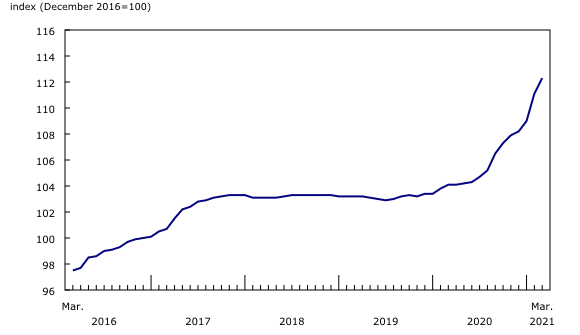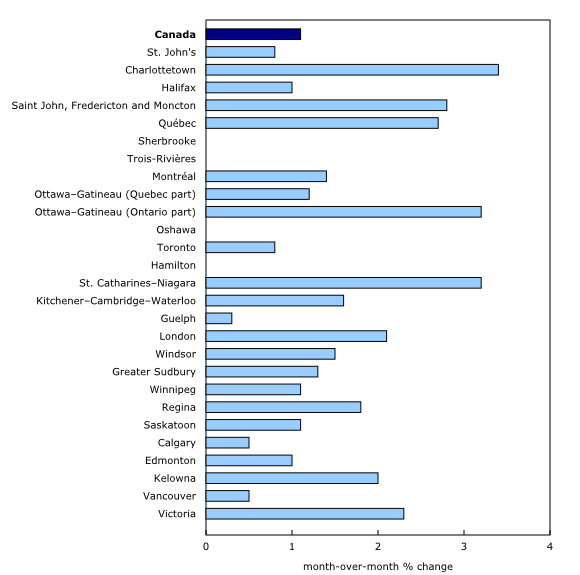New Housing Price Index, March 2021
Archived Content
Information identified as archived is provided for reference, research or recordkeeping purposes. It is not subject to the Government of Canada Web Standards and has not been altered or updated since it was archived. Please "contact us" to request a format other than those available.
Released: 2021-04-22
March 2021
1.1% 
(monthly change)
March 2021
0.8% 
(monthly change)
March 2021
3.4% 
(monthly change)
March 2021
1.0% 
(monthly change)
March 2021
2.8% 
(monthly change)
March 2021
1.4% 
(monthly change)
March 2021
1.3% 
(monthly change)
March 2021
1.1% 
(monthly change)
March 2021
1.4% 
(monthly change)
March 2021
0.7% 
(monthly change)
March 2021
0.8% 
(monthly change)
New home prices rose 1.1% in March nationally, following one of the largest monthly increases on record in February.
New Housing Price Index, monthly change
New house prices in March were up in 23 of the 27 census metropolitan areas (CMAs) surveyed. Prices were unchanged in the remaining CMAs.
The largest monthly increase in new home prices was in Charlottetown (+3.4%), where house prices remained relatively affordable compared with other hot markets in Canada. During the last five years, Prince Edward Island showed the second highest population growth rate among the provinces and territories. Over the same period, this province has been experiencing high interprovincial migration, pushing up the demand for housing. In March, employment (+1.7%) continued to recover and unemployment fell by 1.1%.
New house prices continued to increase in Ottawa and St. Catharines-Niagara (both up 3.2%).
Upward price pressure coming from both housing supply and demand
The strong demand for new houses, fueled by lower borrowing costs and work from home restrictions, continued pushing up new home prices in March. As many home owners looked for larger living spaces, first-time home buyers also rushed to enter the market. Shortages of homes available on the market have also been creating competition between potential buyers, with some builders only releasing a few lots at a time.
On the supply side, increasing construction costs and shortages of construction materials also put upward pressure on new home prices. Builders continued to face higher costs for construction materials such as lumber and other wood products (+5.2%), fabricated metal products (+2.5%), cement and glass, and other non-metallic mineral products (+9.8%), which all increased on a monthly basis in February.
New Housing Price Index, 12-month change
March 2021 marks the one-year anniversary of the implementation of COVID-19 restrictions in Canada. The early predictions anticipating a drop in housing prices did not materialize. In fact, the growth of prices has accelerated in most Canadian cities since the beginning of the pandemic. Continued work from home shifted the demand from large urban centres toward remote and more affordable markets, which offer larger single-family homes.
The 12-month change for March compares, for the last time, pre-pandemic prices with pandemic house prices, as the reference period for the March 2020 data ended on March 15.
For the first time since December 2017, new home prices accelerated on a year-over-year basis in all 27 CMAs surveyed.
Once again in March, Ottawa led the way in year-over-year home price acceleration (+17.3%).
With new home prices still relatively more affordable than those in Toronto, prices in Kitchener-Cambridge-Waterloo rose 17.2% on a 12-month basis.
Year over year, new home prices increased in Regina (+1.5%) for the first time since January 2018. Of the 27 CMAs surveyed, this city had been registering the lone decline since October 2020.
Note to readers
The New Housing Price Index (NHPI) measures changes over time in the selling prices of new residential houses. The prices are those agreed upon between the contractor and the buyer at the time the contract is signed. The detailed specifications for each new house remain the same between two consecutive periods.
The prices collected from builders and included in the index are market selling prices less value-added taxes, such as the federal Goods and Services Tax and the provincial harmonized sales tax.
The survey covers the following dwelling types: new single homes, semi-detached homes and town homes (row or garden homes). The index is available at the national and provincial levels and for 27 census metropolitan areas (CMAs).
The index is not subject to revision and is not seasonally adjusted.
In addition to this monthly release, the NHPI has also been integrated into the Residential Property Price Index (RPPI). The RPPI is a quarterly series that measures changes over time in the prices of residential properties for Montréal, Ottawa, Toronto, Calgary, Vancouver and Victoria. An aggregate for these six CMAs is also available. The RPPI provides a price index for all components of the housing real estate market—new and resale—in addition to a breakdown between houses and condominium apartments.
Products
The article "The resilience and strength of the new housing market during the pandemic" examines the changes in new home prices in Canada for the 27 surveyed CMAs captured in the NHPI and compares the ranking of cities based on prices six months into the pandemic (August compared with February).
The article "Price trends and outlook in key Canadian housing markets" looks at where the housing market was at the onset of the COVID-19 pandemic, sheds light on what has happened since then and explores the challenges of the Canadian market going forward.
The infographic The impact of COVID-19 on Key Housing Markets, part of the series Statistics Canada — Infographics (11-627-M), is available. It provides an outlook on the housing market before, during and after the onset of the COVID-19 pandemic.
The New Housing Price Index: Interactive Dashboard, which allows users to visualize statistics on new housing prices, is available.
The Housing Market Indicators dashboard, which provides access to key housing market indicators for Canada, by province and by CMA, is also available.
For more information on the topic of housing, visit the housing statistics portal.
The video Producer Price Indexes is available on the Statistics Canada Training Institute webpage. It provides an introduction to Statistics Canada's Producer Price Indexes—what they are, how they are compiled and what they are used for.
Statistics Canada launched the Producer price indexes portal as part of a suite of portals for prices and price indexes. It provides users with a single point of access to a wide variety of statistics and measures related to producer prices.
Next release
The New Housing Price Index for April will be released on May 20.
Contact information
For more information, or to enquire about the concepts, methods or data quality of this release, contact us (toll-free 1-800-263-1136; 514-283-8300; STATCAN.infostats-infostats.STATCAN@canada.ca) or Media Relations (613-951-4636; STATCAN.mediahotline-ligneinfomedias.STATCAN@canada.ca).
- Date modified:



